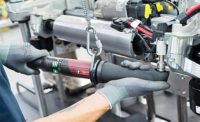Several times before, I have discussed the need for physical testing in the development and validation of bolted joints. However, just as both the quality of the joint and the quality of the joint designer’s knowledge base will be limited by reliance on numerical analysis, the same limitations occur when experience and applied experimentation is all one has to draw from.
After all, the behavior of bolted joints is based on the same mechanical engineering principles whose understanding enhance the chances that planes will fly and bridges won’t collapse. Too many catastrophes and too little advancement would be the result of reliance solely on past experience or experimentation as the basis of engineering application.
Book smarts and skinned knuckles are equally useful when the goal is a product that is sophisticated, economical, safe or cost-effective. Seat-of-the-pants, or the increasingly popular Internet engineering, should be reserved for all other projects.
The proliferation of inexpensive computing power can easily result in a hollowing out of knowledge. Just as I feel much less pressure to improve my dodgy spelling capability since the advent of the spell-checker, many engineers are more adept at outputting data from their laptops than understanding why the results of scenario A differ from those of scenario B.
What if you were asked, “All else being equal, how would the initial bolt tension change if the thickness of clamped parts were doubled?” Someone with a lot of practical experience might have run across this situation previously, and feel they know the answer. Someone else with a bolted joint analysis program can input both variations of the joint and quickly give you an answer; a quantifiable one at that.
Instead, let me suggest a more palatable alternative. Use a simple analysis program to perform a series of “what if” studies that selectively vary common joint variables. The results will provide you with a sensitivity analysis of the impact of these changes, and hopefully, give you a better intuitive feel for joint behavior.
To give that knowledge a better foothold, take time to look at the intermediate calculations and their associated help screens. For the truly ambitious, create your own spreadsheet from handbooks or the VDI 2230 standard. (Send me an e-mail, and I’ll forward you contact information on analysis programs that I’m aware of.)
While many inputs determine joint behavior, these variables can be grouped into the following three fundamental categories:
-
Strength. Material strength properties determine the relative capability of the joint to perform as desired under the loads applied to it. The ability of the bolted joint to develop high clamp loads (so it can act like a nonseparable joint) in a small, cost-effective package is without doubt its greatest competitive advantage.
-
Stiffness. Bolt tension is created by elongation during tightening, with the resulting clamp load causing compression in the parts between the nut member and the head. The relative stiffness, or spring rate, of the bolt and clamped members is a principal factor in determining the behavior of bolted joints under service loads
- Friction. Friction at the interface of fasteners and clamped members has an isolated, but critical role in bolted joint assembly and behavior. Friction is both the most influential and the most elusive variable determining the torque-tension relationship that converts input torque to resulting bolt tension. Friction is equally important in establishing the load that will cause clamped plates to slide against one another when loaded.
So, what is the answer to the question of how grip length impacts initial bolt tension? It depends on the basis of how the bolt is tensioned.
If, as in most cases, the bolt tension is established by torque control, increasing grip length will not change tension, as the torque-tension relationship (T = KDF or the expanded ISO 16047/VDI 2230 relationship) is independent of grip length. This is a convenient fact, because if grip length did influence torque-tension, all torque tables would need to include it.
More basic, the benchtop torque-tension tests on which those tables were based, and fastener finishes are classified, would be valid only for the grip length at which the tests were conducted. However, if angle control were employed to tension the bolt in question, since the relative stiffness between the bolt and the joint members has been reduced, rotating the bolt or nut through the same angle in the thicker joint would result in lower initial bolt tension. A






